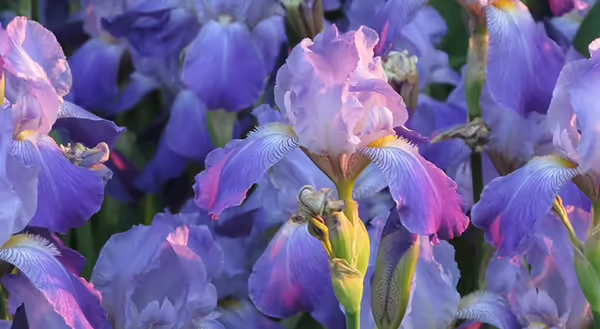
Originally Published by Sandra Mason on 7/22/2000
The Greek goddess Iris walked a rainbow pathway through the sky and the flower named for her has a rainbow of flower colors. Iris is one of the oldest garden flowers. Iris is often seen as the only remnant of a long since abandoned home.
Iris species
Although the most familiar type of iris is the bearded iris, the genus includes 200 or more species, including some North American natives. Species are separated into two major groups - rhizomatous and bulbous. Rhizomes are horizontally growing underground stems that are used as food storage for the plant. The common bearded iris falls into this group as well as the beardless Siberian and Japanese iris.
Bulbous irises form a more typical bulb and include Dutch and reticulate iris. These are planted in October with other bulbs.
Transplanting
The best time to plant and transplant rhizomatous iris is late July through September. Iris loves the heat and drier weather of summer and the summer dividing will reduce the incidence of bacterial soft rot. Most rhizomatous iris should be divided every three to five years. If your iris patch is producing very few flowers, it's time to divide and conquer.
Watch this short 5-minute video on dividing and planting iris from Ken Johnson or read more on his Good Growing blog.
- When transplanting iris, first cut back the leaves to about one third of their height.
- Lift the entire clump with a spade or digging fork.
- Use a sharp knife to separate the rhizomes.
- Dip the knife in ten percent bleach after each cut.
- The new transplants should have a firm rhizome with roots and a fan of leaves.
- Remove and discard the old rhizomes and only replant the younger smaller rhizomes that grow off of the older stems.
Planting
Iris appreciates a sunny well-drained garden spot. When planting iris:
- dig a hole about five inches deep.
- Build a small mound in the middle of the hole.
- Place the rhizome firmly on top of the mound and let the roots fall down the mound.
- Cover the roots with soil so the rhizome is just slightly exposed. Do not plant the rhizome too deep or it may rot.
- Generally iris are planted 18-24 inches apart in groups of three to seven sections of one variety.
- Usually the rhizomes are planted so the leaf fans face in one direction.
Discard damaged iris
While dividing the rhizomes be sure to inspect them for soft rot and iris borer. Iris borer is the worst insect problem irises ever get. The adult iris borer is a brownish moth. She lays her eggs in fall on the iris leaves. The eggs overwinter and hatch into caterpillars during April and May. The caterpillars first bore into the iris leaves. By the end of July the caterpillars move into the rhizomes to eat and mature. In early August the caterpillars move from the rhizome to the soil to pupate into a moth.
When dividing iris, the iris borer will be a mature pink caterpillar inside the rhizome. The rhizome may look fine until your fingers push through to a mushy mess. Bacterial soft rot often accompanies iris borer damage.
Fall sanitation is important in iris borer control. After the first hard frost, remove and destroy or bury the old iris leaves and plant debris to remove the eggs. In small iris patches the borer can also be controlled by squishing the caterpillar in the leaves in April and May.